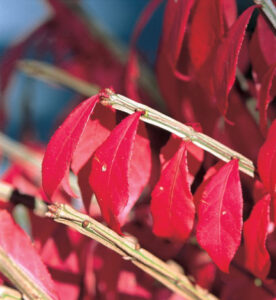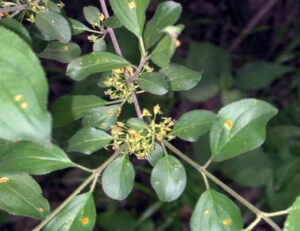JEFFERSON CITY — Oaks, sweet gum, maples, and other native trees are displaying brilliant fall foliage, but across the landscape there are also many colorful invasive shrubs and trees. The Missouri Invasive Plant Council (MoIP), administered by the Missouri Prairie Foundation, encourages Missourians to control bush honeysuckle, Callery pear, burning bush, and other non-native woody plants that invade and threaten native habitats, timber harvests, and farmland.
“Fall is the ideal season for controlling many non-native invasive shrubs and trees,” said MoIP Chair Carol Davit. “Bush honeysuckle’s yellow-green leaves are some of the last to drop, making this invasive shrub highly visible in woodlands. Also, after a hard frost, native vegetation is dormant, so, if using herbicide to treat invasives, it won’t impact native plants.”
MoIP provides comprehensive ID and control information for many common invasive plants in Missouri at its website, moinvasives.org. Below is information from MoIP on several woody invasives to treat now.
Note: Treatment methods may differ considerably if invasives are found in otherwise intact, highly biologically diverse areas, in disturbed areas/altered landscapes, or if invasives are found in or near water. When using chemicals to treat invasives, always read label instructions.
https://moinvasives.org/project/burning-bush-euonymus-alatus/

Fall foliage of burning bush by James H. Miller, USDA Forest Service
Burning bush (Euonymus alatus), native to Asia and a common landscaping shrub, is spreading rapidly into forests and woodlands. In fall, it is readily identifiable by its brilliant red leaves. This deciduous shrub can grow to 20 feet. Two to four corky ridges often form along the length of young stems, though they may not appear on shrubs growing in shaded areas or closed canopies. The opposite, dark green leaves are less than 2 inches long, smooth, rounded, and taper at the tips. The leaves turn bright crimson to purple in the fall. The flowers are inconspicuous, greenish yellow, and have four petals. Flowers develop from late April to June and lay flat against the leaves. The fruits, which appear from September to October, are reddish capsules that split to reveal orange fleshy seeds. Cut stems/trunks with loppers or a saw and then daub the cut stems with a 10% to 20% solution of glyphosate. No surfactant is needed when applying herbicide to cut stems/stumps. Learn more about ID and control of burning bush here.

Bush honeysuckle by Bill Ruppert
Bush honeysuckles (Lonicera maackii and other non-native Lonicera shrub species) are large, upright shrubs reaching 15 to 20 feet tall at maturity. In early summer, white flowers will emerge and change to a pale yellow over time, producing bright red juicy berries in early fall, which are readily eaten by birds, spreading the seeds. Leaves are opposite, 1 to 3 inches long, and narrowly oval with a pointed tip.
These shrubs spread through woodland communities, dominating the understory and shading out native herbaceous plants as well as native shrubs and native tree seedlings. The recommended control varies depending on shrub size and density, as well as landscape type. Small plants can be pulled by hand, as they are shallow-rooted. For larger plants, the method that may be especially desirable for yards or parks is to cut stems with loppers or a saw and then daub the cut stems with a 10% to 20% solution of glyphosate. No surfactant is needed when applying herbicide to cut stems/stumps. More control method information for bush honeysuckle is https://moinvasives.org/project/invasive-bush-honeysuckles-lonicera/

Ligustrum ovalifolium by Leslie J. Mehrhoff
Non-native privets (Ligustrum spp.) are multi-stemmed shrubs reaching up to 16 feet tall at maturity. Four species occur in Missouri. Leaves are small, opposite, with smooth margins, and at nearly a right angle to the stem. The leaf surface is glossy on top and pale green underneath. Chinese privet has a hairy mid-vein on the lower surface, while European privet is hairless on the underside of the mid-vein. White flowers appear from May to June and are abundant and fragrant. Fruits appear in late summer in clusters near the ends of branches. As the fruit ripens, it turns from pale green to dark purple or nearly black.
Wildlife (primarily birds) consume the fruits, thereby spreading the seed and contributing to future invasions. Privet also spreads clonally through its roots. Dense stands often form near creeks, fence rows, and in the understory of woodlands. Leaves remain green for several weeks after the first fall frosts.
The recommended treatment is a foliar application of glyphosate after the first hard frost. A 3% to 4% rate of glyphosate with ammonium sulfate and surfactant is adequate for control, ensuring that the herbicide covers most of the leaves on the shrub. Do not spray the leaves to the point of run-off. Another method is to cut stems/trunks with loppers or a saw and then daub the cut stems with a 10% to 20% solution of glyphosate. No surfactant is needed when applying herbicide to cut stems/stumps. Learn more about ID and control here: https://moinvasives.org/project/invasive-privets-ligustrum/

Common buckthorn by Chris Evans, University of Illinois,
Common buckthorn (Rhamnus cathartica) is much more of a problem north of Missouri; nonetheless, it is gradually increasing in central and eastern Missouri. Early detection and control are critical in reducing its spread, impact, and abundance.
Common buckthorn is a many-branched, shrubby tree with a spreading, irregular crown. Leaves are simple, some appearing alternate, but most are opposite, egg-shaped, abruptly pointed (sometimes rounded) at the tip, and finely toothed. Both upper and lower surfaces are smooth. Leaves have 3 to 5 pairs of veins branching from the midvein that curve along the edges of the leaf. Leaves appear early in spring and are retained late into autumn. Trunks can grow to 10 inches in diameter. The terminal bud is often modified into a spine. Flowers have 4 small, yellowish green petals and appear in clusters from April to June; male and female flowers are usually produced on separate plants. Fruits appear August–September, often remaining until December. Fruits are round, black, small (up to ¼ inch in diameter), juicy, and typically contain 3-4 seeds. Note: There are several native species of buckthorn in Missouri.
Cut stumps can be treated with a 50% solution of glyphosate immediately after cutting. Apply herbicide to individual cut stumps with a low-pressure hand sprayer or by daubing herbicide on each cut stump with a sponge applicator. As with bush honeysuckle, fall is the preferred time to cut and stump-treat buckthorn because 1) buckthorns retain green leaves late into the fall, making it easy to find them, and 2) most native vegetation is dormant, minimizing the potential harm to non-target plants. Learn more about buckthorn ID and control here: https://moinvasives.org/project/common-buckthorn/
To learn more about invasive plant identification and control, MoIP events, and other information, subscribe to the free MoIP quarterly e-newsletter, State of Invasives, https://moinvasives.org/join-newsletter/
